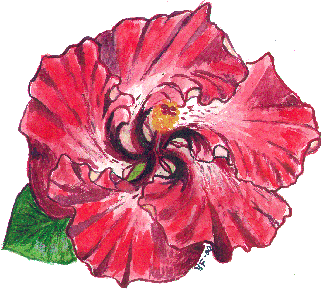
 |

|
I'm sure that sometimes you have heard talk about nomenclatures and wonder why you should care. Well, since you are visiting a hibiscus site I assume you like hibiscus? If you like hibiscus the nomenclature matters to you. How? What is a nomenclature?A nomenclature (nomen = name + calare = call out) is simply a namelist, in this case a list of names of hibiscus varieties (cultivars). Instead of the hibiscus nomenclature we could say the hibiscus namelist. To simplify we'll use the word namelist in the remainder of this message. What is the purpose of the namelist?The purpose of the namelist is to keep a permanent record of all cultivated varieties of hibiscus, both in cultivation and extinct. By listing all the names we can know at a glance what hibiscus varieties exists. It will also help to avoid name duplication, a serious problem. Think about it. You have seen a stunning picture of a hibiscus cultivar and now you want to get one for yourself. So you buy one, just to find out that it's not at all the plant you expected but another carrying the same name. Wouldn't that be frustrating? The namelist will help you avoiding such disappointments. The namelist is rather similar to the pedigree of race horses. Imagine if nobody kept breeding records of these animals. Why, we wouldn't even have any thoroughbred horses if it wasn't for the stud books. Record keeping is important for improving the breed, weed out weaknesses and encourage good points. Similarly, the hibiscus nomenclature will also aid in improving the species, grow better, healthier hybrids than those of times past. The namelist is also a historical record of the development of hibiscus, perhaps less interesting to the average grower but important to those wanting to trace the origin of the stunning blooms we have today. What information does the namelist contain?In general, the name is the least of it. Most varieties have a detailed listing covering everything from flower size to bush, growth habit, hybridizer, the cross itself etc. Here is the nomenclature entry for High Voltage: As you can see there is lots of information here both for amateur growers, flower show judges and hybridizers (plant breeders). How can I benefit from it?Are you a grower? If you look at the entry for High Voltage above you can at a glance see that this excellent cultivar is white and blooms a lot with 9-10" flowers on a tall and vigorous bush. Do you want to grow High Voltage? Well, now you know how large it becomes and whether it suits your need. If you are a hybridizer you may want to take note of the excellent qualities High Voltage has. But you are trying to breed a miniature bush. Perhaps a fast grower like High Voltage isn't the choice for you. Now you don't have to make the cross just to find out that your High Voltage babies are likely to reach for the sky. By looking at all the records of hybridizers using High Voltage you can get a good grip on what traits this particular variety passes on and make an informed decision rather than letting pure luck govern your breeding efforts. The former is many times more likely to result in a "keeper." Well, these are some reasons why the namelist = nomenclature matters to you! |